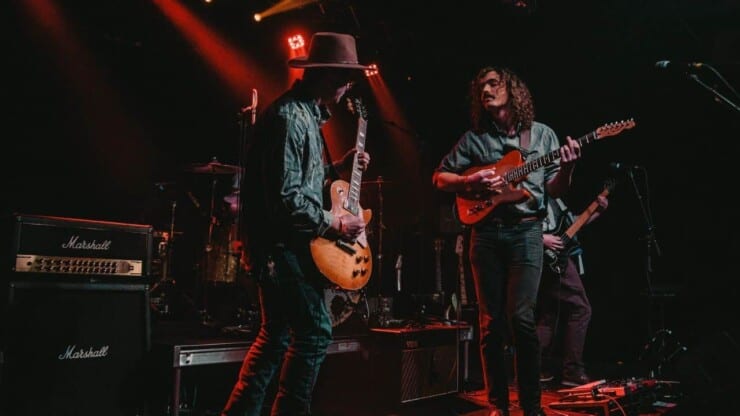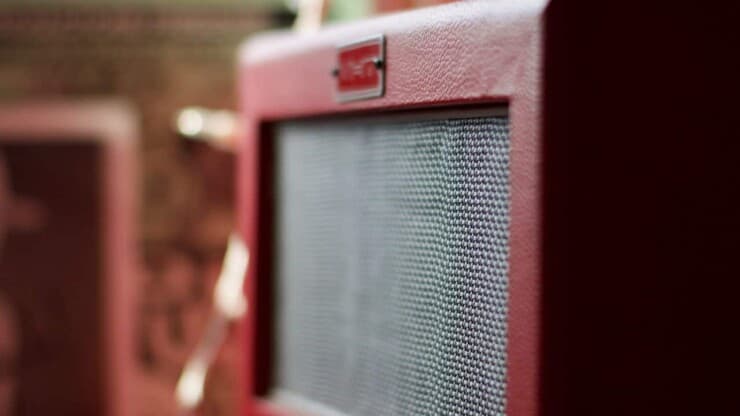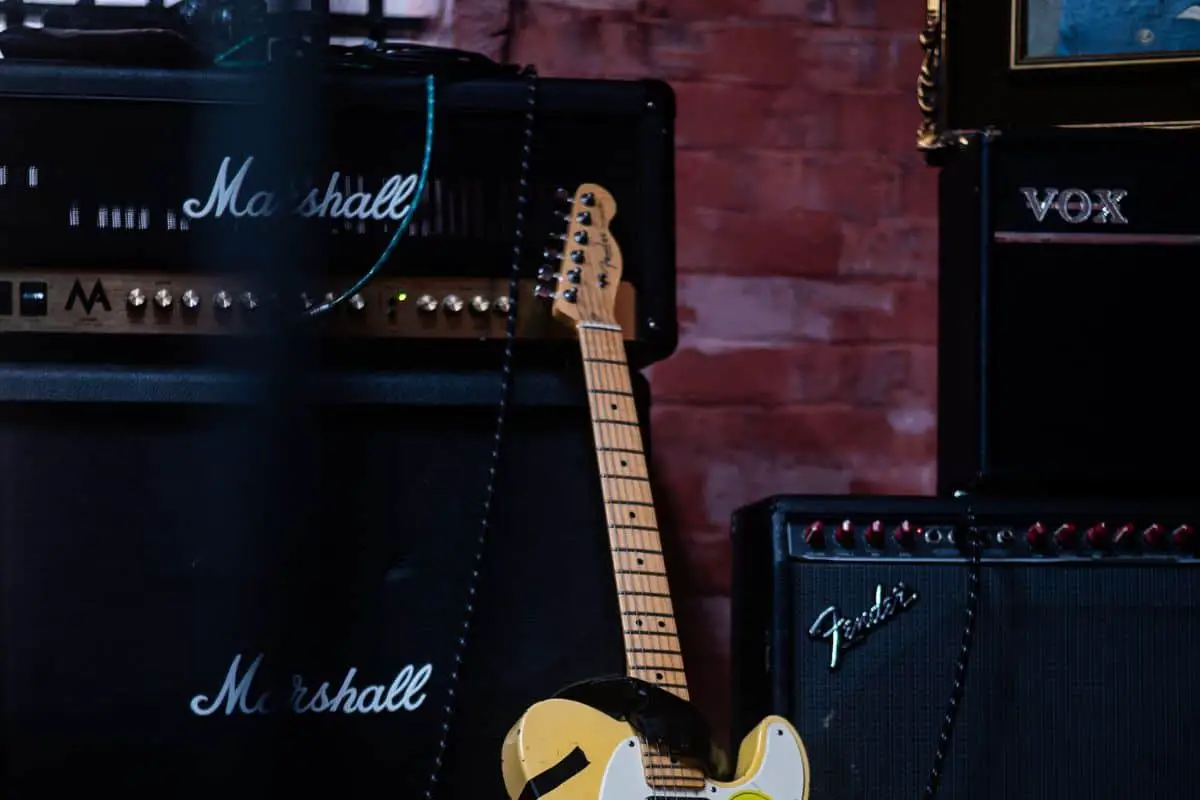Have you decided to have two guitar amps in your rig, but you don’t know how to connect two guitar amps together? If so, then this article is just what you need.
Connecting two guitar amps together can be done by daisy-chaining them together. The easiest way of doing this would be by connecting the guitar to the input of one amp and outputting the signal to the input of the other amp. Moreover, there are other methods as well.
In this article, you’ll get to know all about daisy-chaining amps, how to connect two guitar amps together, the pros and cons of connecting two amps together, how to run 2 guitar amps together, and more.
Would it be possible to connect two guitar amps?
Yes, it is possible to connect two guitar amps. However, the ability to do so will depend on the amps that you’re planning to daisy-chain together. The important thing to keep in mind will be the correct way of connecting the amps to avoid damage to get the sound you want.
Sometimes, using a single guitar amp doesn’t provide enough power and volume needed for a performance. Many guitarists incorporate two or more guitar amps into their guitar rig for maximizing the tone and dynamics.
Daisy-chaining guitar amps is definitely a possibility. The simplest way of achieving that is by connecting the guitar to the input of the first amp and outputting the signal to the input of the other. However, there are a few important measures that you need to take if you want to avoid any noise issues. Daisy-chaining guitar amps is the process of sending your guitar’s output to multiple amps. This will increase the total volume while impacting the overall tone of your guitar rig. There are multiple ways how to connect 2 guitar amps together and playing the guitar.
Why to daisy-chain two guitar amps together?
Daisy-chaining or jumping is the act for how to connect 2 amps together for amplifying the sound of one guitar. This idea originates from the need to have more volume. Cranking two amps will be comparatively louder than one, right?
- By daisy-chaining two guitar amps together, you’ll be able to double the volume in most cases. Moreover, you can even create a stereo loud field when you’re performing live.
- Another use for daisy-chaining amps together can be to chain two less powerful amps to match the volume of your bandmates if they’re using louder maps.
- Apart from sheer volume, different amps will also have different sound characteristics. Daisy-chaining two amps will give you a sound that you might not get from either of the amps individually.
How to connect two guitar amps together?
You’re having two amps that you love using, but switching between them feels like a big chore. Or maybe you have two Marshall amps that you can combine to blow the roof off during your next performance. So, how to connect two guitar amps together and make them work? Simple, by daisy-chaining them or tone-stacking them. Wondering how to split guitar signal to 2 amps and make them function together.
Fortunately, there are a couple of ways you can split the guitar’s signal and distribute them to two amps. Each method comes with its own pros and cons. You’ll need to go through them all and decide which route seems the best. Ultimately, it’ll depend on what you want to do and how much can you spend.
Daisy-chaining method
This is probably the simplest method to connect two guitar amps together, and it requires the least equipment. All you’ll need to gather are two instrumental jack cables, an electric guitar, and two amplifiers. Although this route is the easiest and most commonly used, there are a few potential trade-offs.
First, you’ll have to check the number of inputs and outputs present in your guitar amps. One of your amps has to have two or more inputs. Otherwise, you cannot continue with this method, and you’ll have to choose from the remaining two options.
If both of your guitar amps have multiple inputs, it won’t matter which order you’ve set them up in. Meanwhile, if only one of the amps has two or more inputs and the other one has just one, you’ll be plugging the guitar into the amp with multiple inputs. To achieve that, it needs to be positioned first in the chain. Once the two amps have been positioned, you should grab two instrument jack cables. One of the cables must be plugged into the guitar’s output. The other end should be plugged into the first input of the first amp.
After that, plug the second guitar cable into the second input of the first amp. The other end of the cable should be plugged into the first input of the second amp. This way, you’ll be forming a daisy chain between the two amps. You may be wondering how the input from the first amp will act as an output and send the guitar signal to the input of the second amp. This is possible as the vast majority of inputs on dual-input amps are in parallel and connected. This is how it becomes possible to send the signals from one amp to the other.

A common issue that you might come across in this method is that the outputs from the two amps could be out of phase with each other. It means that the waveforms might cancel each other out, which could lead to certain frequencies getting subdued. Phase issues will be easy to hear. If you’re noticing that the outputs aren’t sounding as full-bodied and substantial as they normally do, you should take the speaker cables from one of the amps and reverse them. This instantly puts the amps in phase with each other while rectifying the issue.
Buffered AB/Y Splitters
Another easy way of linking two guitar amps together is by using a tool called AB/Y Splitter. However, before rushing off to find any splitter, you’ll need to ensure that the one you’re using is buffered. AB/Y Splitters will be largely hit-and-miss when considering the signal clarity and performance they offer. You might find many decent options at cheap prices that’ll do the job. However, if you’re looking for maximum reliability, an AB/Y Splitter like the Orange Amp Detonator will be your best bet.
It’s essential to make the distinction between active and passive splitters. Passive AB/Y splitters will weaken the guitar’s signals as they’ll be transmitted to the multiple amps, halving the signal strength. If you’re looking to maintain the natural tone and signal strength of your guitar and amp, a passive AB/Y splitter will likely disappoint you. Active splitters will improve this issue, but they often color the tone of the guitar, especially the cheaper ones.
This is where the buffered AB/Y splitters come in. Using a buffered AB/Y splitter will help you ensure that the signal strength is maintained. Moreover, it’ll also improve the performance of all the other pedals in your signal chain. Buffered AB/Y splitters normally include useful features like phase switching, impedance matching, and ground loops. This will allow you to tailor the settings of the pedal for, ensuring that they’re optimally suited to two or more amps you’re going to combine.
The more affordable option will be to go with the passive AB/Y splitter. If you’re running into noise problems, like an increase in electrical humming or ground loops issue, you can always combine the splitter with a Direct Input (DI) Box. These boxes are commonly used in recording and live performance settings. This will require you to plug the guitar into the input of the DI box. Then, you should hook the first amp up to the output of the DI box.
Lastly, you should connect the other output to the second amp. This method will be very reliable. However, there is no guarantee that both of the amps will sound like they do when used individually. This happens as the DI box might cause coloration and the input impedance of both amps combined would be different from when used individually.
Using guitar effect pedals for connecting two amps together
If your guitar amps don’t have two or more inputs, this is a simple method that you can use for connecting them. This is a highly recommended method, and it’ll involve using an effects pedal with stereo outputs. Many popular guitar stompboxes come with two outputs installed for signal splitting. Say that you’re using a pedal like the popular Electro-Harmonix Micro Pog, an octave shifter. This pedal will come with two outputs – Dry Out and Effect Out. It is designed for facilitating signal splitting. This will allow you to send two separate outputs from the effects pedal and into the amps.
This technique is commonly used by bassists and guitarists. It’ll allow you to separate the dry and wet signals, making it easy to send them to different amps. However, you can even use a dual-output pedal solely for linking the two amps and playing identical signals from them.
When using the Micro Pog, you’ll have to plug your guitar into the pedal’s input using a standard instrument jack. Then, a second jack cable should be plugged into the Effect Out, while the other end will be plugged into the input of the first amp. Another jack cable must be plugged into the Dry Out and then sent to the input of the second amp. This will help you link the two amps, with the pedal acting as the middle ground between them.

It’s important to remember when using this method for connecting two amps that the signals will only get identified once the Micro Pog pedal has been turned off. Once the effect gets engaged via the footswitch, the signal from the Effect Out gets subjected to the pitch-shifted effect. Moreover, it’ll get played through the second amp.
If you’re using multiple effects pedals in the signal chain, you can isolate certain effects. Then, send them over to the second amp. This will be a great way of thickening up the tone as it’ll mean that when you’re engaging the chosen effects, the clean sound of the guitar is still present in the dry amp. Guitarists often use this technique if they’re playing the guitar in a two or three-piece band. It’ll create the illusion of the second or third guitar double-tracking the notes being played. Moreover, it’ll allow them to be considerably more precise when sculpting their processed tones.
Pros and cons of connecting two guitar amps together
The biggest benefit of connecting amps together is that you’ll get more volume as you’re hearing the guitar in stereo. Having extra volume will be great for performing live. It’ll allow your guitar to compete with the volume of the rest of the band. The ability to play the guitar in stereo will be a huge draw towards connecting two amps together. This is even more useful if you’re utilizing guitar effects pedals like stereo delays. This means that the stereo effects will play in stereo, creating interesting sonic sounds that you might not get with a single amp.
The downside of connecting two amps together is that the two amps might behave unpredictably when connected. This might result in issues with tone, volume, and phasing. Phasing is a fairly common issue when combining two guitar amps together. It refers to how the sound waves of individual amps interact with each other. If the two amps are out of phase, it’ll mean that their waveforms are canceling out each other.
Are there any drawbacks to connecting two guitar amps together?
Chasing more volume than what you’d normally get from an amp comes with its risks. The easiest way of daisy-chaining amps will also be the riskiest way to do it. If you’re running the guitar into an amp with Speakers Out and running the speakers outs into another amp, there will be a risk of delivering too much power into the second amp. It can easily overdrive the amp to the point where you may start seeing smoke. You’ll need to avoid this from happening at all costs. Regardless of the method you’re going for, ensure that it is safe and consider the risks when connecting amps together.
Phasing issues
Connecting two guitar amps together could result in the sound coming from the amps sounding incomplete. Sometimes, you might lose the low-end and generally, the sound will not be well-rounded like you’re used to having. Phasing issues can be resolved very easily through. If you’re unplugging the guitar cables from one of the amp outputs, reversing the way you’re plugged in will put them back in phase.
Amp tone
Connecting two guitar amps together can change the tone of your amps as well. The amp you’ve plugged the guitar into can sometimes color the tone of the second amp that it’s chained to. This makes the second amp sound similar to the amp that your guitar is plugged into.
Meanwhile, it’s usually seen as both a positive and negative feature of connecting two amps together. If you’re running an amp that you love the tone of into another amp that you aren’t as crazy about, then it’ll be a great thing. However, if you want the amps to deliver their unique tones, then you’re out of luck with the daisy-chaining method.
What is the best way of connecting two guitar amps together?
Although daisy-chaining is the most common way to connect two guitar amps, there are better ways too. These methods include AB/Y splitters and guitar effects pedals. Using these methods means that you’ll be able to avoid the pitfalls of daisy-chaining, like overdriving the second amp. Here, you’re essentially splitting the guitar’s sound instead of duplicating the sound from the amp.
Is amp stacking the same thing as daisy-chaining two amps?
No, amp stacking and daisy-chaining are two very different things. Amp stacking is essentially the combination of an amp head being connected to one or more guitar cabinets. The amp heads will amplify the guitar input, but you will not have a speaker. Instead, you’ll be connecting them to a cabinet, which will act as a speaker. Amp heads are designed to be hooked to multiple cabinets, and they often come with 2-3 outputs to achieve that.
The reason amp stacking is different from daisy-chaining amps is that amp heads are designed for connecting to multiple cabinets. These cabinets will be equally amplified by the same amp head. Cabinets are very similar to guitar amps. However, instead of amplifying the guitar, they’ll take the signal from the amp head and make it louder. The primary reason why amp stacking is different from daisy-chaining is that when you’re connecting two amps together, both the amps will amplify the signal individually.
Conclusion
Thank you for reading. Hopefully, now you know a lot more about daisy-chaining amps, how to connect two guitar amps together, the pros and cons of connecting two amps together, how to run 2 guitar amps together, and more. There are multiple methods to connect two guitar amps together, including the daisy-chaining method, using AB/Y splitters, and using the foot pedals. The easiest way is by connecting the guitar to the input of one amp and then outputting the signal to the input of the other amp.



